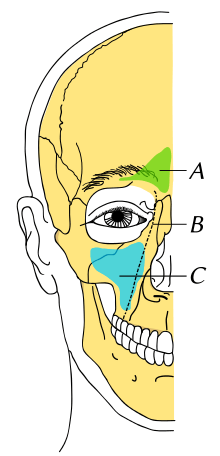Sinus implant

A Sinus implant is a medical device that is inserted into the sinus cavity. Implants can be in conjunction with sinus surgery to treat chronic sinusitis and also in sinus augmentation to increase bone structure for placement of dental implants.[1]
Types
Maxillary implant
A maxillary implant is an implant that is placed between jaw and the maxillary sinuses. It is inserted during a sinus lift or augmentation and used to increase the amount of bone to support dental implants.[1] Implants are either inserted after drilling or by using a non-drilling method known as the osteotome technique.[1] Issues such as bulging within the sinuses can occur with maxillary implants.[2][3]
Maxillary implants can also be made using Choukroun's technique with subsinus filling material.[4] The material is used to stimulate natural bone regeneration. A clinical study of this technique detailed all patients within the study had continuous stable implants six months after placement. It also showed vertical bone gain in all subjects.[4]
Rhinoplasty
Numerous different types of material have been used as sinus implants during rhinoplasty procedures. Plaster of Paris is often used during rhinoplasty and implanted into the frontal sinus.[5] Implants used in rhinoplasty have also been reported to cause enophthalmos.[6]
Sinus stent

Propel mometasone furoate implant is a sinus implant used to treat inflammation associated with sinusitis. It is used as a stent and inserted into the sinus cavity during sinus surgery[7] after an ethmoidectomy procedure, which removes bony partitions within the ethmoid sinus.[8] It delivers steroids over a 30-day period to treat chronic sinusitis.[9] The implant dissolves over four to six weeks and does not require removal from the sinus cavity, as well as reduces the need for additional surgical procedures and steroid pills, which can have detrimental side effects.[10] The device was approved by the United States Food and Drug Administration on August 11, 2011.[11]
A randomized, double-blind pilot study of sinus stents using 43 patients during an eight-week trial period showed no adverse effects.[12] The intra-patient control design compared a drug-eluting implant to a non-steroid eluting implant. It also showed adhesion rates of 5.3% for those using Propel in comparison to 21.1% for those who received a non-steroid eluting implant.[13][14] The trial showed less than 10% of stent material present after 30 days with the remaining completely absorbed by the end of the eight week trial.[12][13]
See also
References
- 1 2 3 Summers RB (February 1994). "A new concept in maxillary implant surgery: the osteotome technique". Compendium. 15 (2): 152, 154–6, 158 passim; quiz 162. PMID 8055503.
- ↑ Sbordone L, Toti P, Menchini-Fabris G, Sbordone C, Guidetti F (2009). "Implant success in sinus-lifted maxillae and native bone: a 3-year clinical and computerized tomographic follow-up". The International Journal of Oral & Maxillofacial Implants. 24 (2): 316–24. PMID 19492648.
- ↑ Tidwell JK, Blijdorp PA, Stoelinga PJ, Brouns JB, Hinderks F (August 1992). "Composite grafting of the maxillary sinus for placement of endosteal implants. A preliminary report of 48 patients". International Journal of Oral and Maxillofacial Surgery. 21 (4): 204–9. doi:10.1016/S0901-5027(05)80219-X. PMID 1328414.
- 1 2 Simonpieri A, Choukroun J, Del Corso M, Sammartino G, Dohan Ehrenfest DM (February 2011). "Simultaneous sinus-lift and implantation using microthreaded implants and leukocyte- and platelet-rich fibrin as sole grafting material: a six-year experience". Implant Dentistry. 20 (1): 2–12. doi:10.1097/ID.0b013e3181faa8af. PMID 21278521.
- ↑ Raghavan U, Jones NS, Romo T (2004). "Immediate autogenous cartilage grafts in rhinoplasty after alloplastic implant rejection". Archives of Facial Plastic Surgery. 6 (3): 192–6. doi:10.1001/archfaci.6.3.192. PMID 15148130.
- ↑ Eloy JA, Jacobson AS, Elahi E, Shohet MR (June 2006). "Enophthalmos as a complication of rhinoplasty". The Laryngoscope. 116 (6): 1035–8. doi:10.1097/01.mlg.0000217254.22699.09. PMID 16735922.
- ↑ Bleier BS, Schlosser RJ (2011). "Endoscopic anatomy of the postganglionic pterygopalatine innervation of the posterolateral nasal mucosa". International Forum of Allergy & Rhinology. 1 (2): 113–7. doi:10.1002/alr.20011. PMID 22287329.
- ↑ Kennedy DW (November 2012). "The PROPEL™ steroid-releasing bioabsorbable implant to improve outcomes of sinus surgery". Expert Review of Respiratory Medicine. 6 (5): 493–8. doi:10.1586/ers.12.53. PMID 23134241.
- ↑ Lee JT, Han JK (December 2013). "Sinus implants for chronic rhinosinusitis: technology evaluation". Expert Opinion on Drug Delivery. 10 (12): 1735–48. doi:10.1517/17425247.2013.839654. PMID 24088141.
- ↑ "Intersect ENT Propel mini Bioabsorbable Sinus Implant FDA Cleared". med Gadget. 12 November 2012. Retrieved 3 January 2013.
- ↑ "Medical Devices – Propel P100044". U.S. Food & Drug Administration. Retrieved 3 January 2014.
- 1 2 Murr AH, Smith TL, Hwang PH, et al. (2011). "Safety and efficacy of a novel bioabsorbable, steroid-eluting sinus stent". International Forum of Allergy & Rhinology. 1 (1): 23–32. doi:10.1002/alr.20020. PMID 22287304.
- 1 2 Fink, Jennifer L. W. (December 2011). "Drug-Eluting Sinus Stent Hits the Market: May help maintain patency after FESS". ENT Today. Retrieved 7 December 2013.
- ↑ Pedersen, Amanda (22 August 2011). "NewCo on the block: Intersect ENT wins PMA for drug-releasing implant". Medical Device Daily. Retrieved 8 December 2013.
